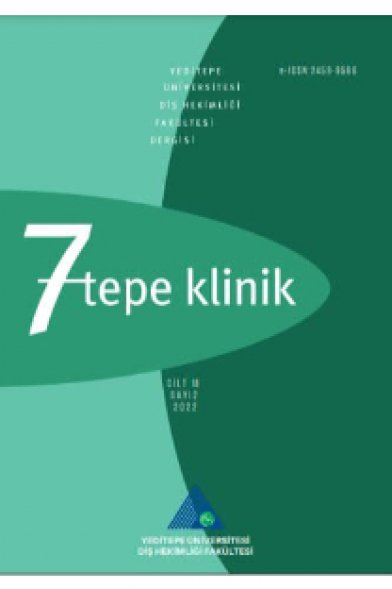Multidisciplinary treatment for a young patient with severe bone loss from a trauma: A case report
Travmaya bağlı ciddi kemik kaybı olan genç bir hastanın multidisipliner yaklaşımla tedavisi: Bir olgu sunumu
___
- Singaram M, G SV, Udhayakumar RK. Prevalence, pat- tern, etiology, and management of maxillofacial trauma in a developing country: a retrospective study. J Korean Assoc Oral Maxillofac Surg 2016; 42:174-181.
- Petersson EE, Andersson L, Sorensen S. Traumatic oral vs non-oral injuries. Swed Dent J 1997; 21:55-68.
- Andreasen JO, Andreasen FM, Andersson L, Andreasen JO. Textbook and color atlas of traumatic injuries to the teeth. (ed. 4th). Oxford, UK ; Ames, Iowa, Blackwell Munks- gaard, 2007.
- Qudah MA, Bataineh AB. A retrospective study of se- lected oral and maxillofacial fractures in a group of Jorda- nian children. Oral Surg Oral Med Oral Pathol Oral Radiol Endod 2002; 94:310-314.
- Jain A, Baliga S. Rehabilitation of Avulsed Teeth in Frac- tured Jaws via Bone Grafting and Implant Placement: Re- port of Two Cases. J Dent (Tehran) 2015; 12:542-549.
- Derks J, Hakansson J, Wennstrom JL et al. Effectiveness of implant therapy analyzed in a Swedish population: ear- ly and late implant loss. J Dent Res 2015; 94:44S-51S.
- Raghoebar GM, Batenburg RH, Vissink A, Reintsema H. Augmentation of localized defects of the anterior maxil- lary ridge with autogenous bone before insertion of im- plants. J Oral Maxillofac Surg 1996; 54: 1180-1185; dis- cussion 1185-1186.
- Garber DA, Belser UC. Restoration-driven implant place- ment with restoration-generated site development. Com- pend Contin Educ Dent 1995; 16: 796, 798-802, 804.
- Suer BT, Yaman Z. Harvesting Mandibular Ramus Bone Grafts Using Ultrasonic Surgical Device: Report of 20 Cas- es. J Dent Oral Disord Ther 2014; 2: 1-5.
- Khoury F, Antoun H, Missika P, Bessade J. Bone aug- menation [i. e. augmentation] in oral implantology. Lon- don ; Chicago, Quintessence Pub., 2007.
- Atil F, Kocyigit ID, Suer BT et al. Clinical Evaluation of the Use of Tibial Bone Grafting in Dentoalveolar Recon- structive Surgery. Med Princ Pract 2016; 25: 72-78.
- Sittitavornwong S, Gutta R. Bone graft harvesting from regional sites. Oral Maxillofac Surg Clin North Am 2010; : 317-330, v-vi.
- Dasmah A, Thor A, Ekestubbe A et al. Particulate vs. block bone grafts: three-dimensional changes in graft volume after reconstruction of the atrophic maxilla, a year radiographic follow-up. J Craniomaxillofac Surg ; 40: 654-659.
- Navarro Cuellar C, Caicoya SJ, Acero Sanz JJ et al. Mandibular reconstruction with iliac crest free flap, naso- labial flap, and osseointegrated implants. J Oral Maxillo- fac Surg 2014; 72: 1226 e1221-1215.
- Brugnami F, Caiazzo A, Leone C. Local intraoral autol- ogous bone harvesting for dental implant treatment: al- ternative sources and criteria of choice. Keio J Med 2009; : 24-28.
- Misch CM. Ridge augmentation using mandibular ramus bone grafts for the placement of dental implants: presentation of a technique. Pract Periodontics Aesthet Dent 1996; 8: 127-135; quiz 138.
- Soehardi A, Meijer GJ, Strooband VF et al. The poten- tial of the horizontal ramus of the mandible as a donor site for block and particular grafts in pre-implant surgery. Int J Oral Maxillofac Surg 2009; 38: 1173-1178.
- Nowzari H, Aalam AA. Mandibular cortical bone graft part 2: surgical technique, applications, and morbidity. Compend Contin Educ Dent 2007; 28: 274-280; quiz 272.
- Aalam AA, Nowzari H. Mandibular cortical bone grafts part 1: anatomy, healing process, and influencing factors. Compend Contin Educ Dent 2007; 28: 206-212; quiz 213.
- Andersson L, Andreasen OA. Traumatic Dental Inju- ries. In Andersson L, Kahnberg K, Pogrel MA (eds), Oral and Maxillofacial Surgery, Singapur. Wiley-Balckwell; p.799-817.
- Belser UC, Grutter L, Vailati F et al. Outcome evaluation of early placed maxillary anterior single-tooth implants using objective esthetic criteria: a cross-sectional, retro- spective study in 45 patients with a 2- to 4-year follow-up using pink and white esthetic scores. J Periodontol 2009; : 140-151.
- Chang M, Wennstrom JL, Odman P, Andersson B. Im- plant supported single-tooth replacements compared to contralateral natural teeth. Crown and soft tissue dimen- sions. Clin Oral Implants Res 1999; 10: 185-194.
- Happe A. Use of a piezoelectric surgical device to har- vest bone grafts from the mandibular ramus: report of 40 cases. Int J Periodontics Restorative Dent 2007: 27: 241
- Khoury F, Hanser T. Mandibular bone block harvest- ing from the retromolar region: a 10-year prospective clin- ical study. Int J Oral Maxillofac Implants 2015; 30: 688
- Ma L, Stubinger S, Liu XL et al. Healing of osteotomy sites applying either piezosurgery or two conventional saw blades: a pilot study in rabbits. Int Orthop 2013; 37: 1603.
- Yaman Z, Suer BT. Clinical comparison of ultrasonic surgery and conventional surgical techniques for enucle- ating jaw cysts. Int J Oral Maxillofac Surg 2013; 42: 1462
- ISSN: 2458-9586
- Yayın Aralığı: 3
- Başlangıç: 2005
- Yayıncı: Yeditepe Üniversitesi Rektörlüğü
Yaşar Meriç TUNCA, DURSUN ALİ ŞİRİN
Evaluation of different instrumentation systems for apical extrusion of debris
RECAİ ZAN, HÜSEYİN SİNAN TOPÇUOĞLU, İHSAN HUBBEZOĞLU, JALE TANALP, Meric KAZANDAĞ KARAPINAR
Diş renkleşmeleri ve beyazlatma tedavileri
Zümrüt Ceren ÖZDUMAN, Çiğdem ÇELİK
Partial edentulism and treatment options
Zeynep KAYAHAN ÖZKURT, Ceyda TOMRUK ÖZÇAKIR, Ender KAZAZOĞLU
Prosthetic restoration types of dental implants
Zeynep KAYAHAN ÖZKURT, Ender KAZAZOĞLU
Endodontik-periodontal lezyonlu mandibular moların kombine tedavisi: Bir olgu sunumu
Fatma KANMAZ, Turan Emre KUZU, RECAİ ZAN, DEMET ALTUNBAŞ
A methodological study on improving a new orthodontic face mask
NURHAT ÖZKALAYCI, MEHMET YETMEZ
Multidisciplinary treatment for a young patient with severe bone loss from a trauma: A case report
Berkay Tolga SÜER, CUMHUR KORKMAZ
Classification and current treatment options of endo-perio lesions
